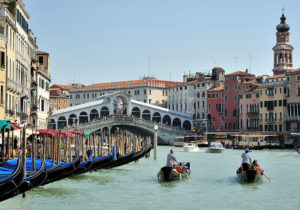Here’s another in our occasional series on traveling the eco-friendly way. If you have a destination you’d like us to explore, please let us know.
Venice holidays bring to mind rich cultural history, beautiful scenery, and romantic attractions. But a holiday in this fabled city takes its toll. Over 50,000 people visit its squares and canals every day during the height of the tourist season, threatening both the built environment and the area’s famous lagoons. Why not plan an eco-vacation to Venice, Italy and lower your carbon footprint in this unique UNESCO World Heritage Site? Here’s how to get started.
Choose youth hostels and self-catering accommodations. These types of accommodations generally use much less energy than a typical hotel. Plus, they allow you to cook your own meals, so you can take advantage of food stands and farmers markets to buy delicious local food.
Locate near public transportation hubs. From trains to buses to water taxis, public transportation in Venice gives you plenty of ways to get around without driving your own car. Websites for most accommodations should indicate how close they are to public transportation; you should be able to find lodging within 15 minutes of a bus stop or water taxi stand.
Rent a bike. Though it is actually illegal to bicycle in historic Venice, you can enjoy the surrounding countryside on two wheels. Plenty of websites offer guided tours, or you can contact a local bicycle rental shop when you arrive. On one popular trip, you would take a water taxi from St. Mark’s Square to the island of Lido, rent a bike there, and ride along the Murazzi, a 5km stone breakwater that dates back to the 18th century. To rent your bike, say Noleggio bici.
Recharge your phone and other electronics via solar energy. Rather than find an electrical outlet whenever you need a charge, use a compact solar charger to repower your mobile devices.
Bring your own reusable water bottle and shopping bag. It’s not unusual to see plastic bags and water bottles floating in the canals alongside the gondolas. All of this plastic will eventually end up in the Adriatic Sea, where it will add to the epidemic of microplastic that’s polluting the world’s oceans. Bring your own reusable water bottle, preferably one that comes with its own filter, and you’ll have good drinking water whenever you need it. Carry a reusable shopping bag, too, which you can use for groceries, souvenirs, or anything else you’d otherwise put in a throwaway bag. One that collapses into a little sac is ideal, since you can easily tuck it away in a pocket, purse, or backpack when you’re not using it.
Fly direct, and offset your energy use with carbon credits. In all likelihood, you will take a plane to Italy, which will burn a LOT of fuel. Offset the carbon emissions from your trip by buying carbon credits that will be used to support development of renewable energy like solar and wind. Flying non-stop rather than taking several planes is also more fuel efficient.
Other ideas? How do you minimize your environmental impact when you travel? Please share!
















